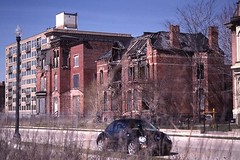Interesting stuff from newspapers...
I have read newspapers since I was 8 or 9 years old, so the fact that newspapers are dying these days is something I regret deeply. Going to Chicago for a conference recently, and reading an anemic Chicago Tribune tabloid version (the broadsheet version isn't sold on newsstands any longer) was really disappointing. In high school, I used to travel to a drug store in Birmingham Michigan and buy the Sunday Chicago Tribune...
1. That Broadway theater productions are increasingly corporatized "properties" that are repurposed content in many forms, a la the Disney Productions. See "Disney Ponders How to Sell ‘Lion King,' ‘Little Mermaid' and ‘Mary Poppins'" from the New York Times.
2. Who gets memorialized in street renaming, police officers killed in the line of duty, or people killed wrongly by police officers? See "Renaming a New York Street for Sean Bell Reopens a Controversy" from the New York Times.
3. Local government can be a conundrum. There are many small governments, and high costs. On the other hand, having a responsive local government entity matters too. But Tom Brokaw, in "Small-Town Big Spending" an op-ed in the New York Times, focuses on the costs.
4. I find it intriguing that the New York Times, in the editorial "Unreasonable Search," believes that the 13-year-old girl who was strip-searched at school was searched unconstitutionally, while the Washington Post believes otherwise, see "Strip Searches in School: The Supreme Court must weigh the rights of students against the duty of school officials to protect safety."
5. The Wall Street Journal has an article, "Artists vs. Blight" about the opportunity artists have to buy properties and do art in declining cities like Detroit and Cleveland. I have called arts-driven revitalization strategies in cities like Pittsburgh or Baltimore being driven by "a desperate willingness to experiment" because there were few other alternatives.
In and of themselves, artists can't rebuild an economy. But they can help stabilize particular neighborhoods and areas within a declining region, and that's important. In weak areas of strong real estate markets, eventually artists will be displaced, as the improved area becomes in demand and subject to market forces.

Vacant disinvested buildings on Alfred Street, Brush Park neighborhood, Detroit. Submitted to the New York Times by Pete Bacevich.
6. I really enjoy reading the "House and Home" section of the Weekend Edition of the Financial Times. This past Saturday's edition has articles worth saving on almost every page.
a. "Delighted, Tunbridge Wells" is about the regeneration (that's the term the Brits use, we say "revitalization") of a community about one hour's railroad commute to London.
b. "Creative community" is about design districts and revitalization, specifically the Zona Tortona in Milan, Italy. A sidebar discusses design districts in London, Helsinki, Miami, and Toyko.
c. Edwin Heathcote, the architecture writer, has been publishing a once/month column on the "symbolic home." This month's installement is on halls, "First impressions."
d. There is a great article about how the highest end condominium buildings in New York City are being designed in "prewar-style limestone, granite and brick," not glass... "The old new."
e. Plus this article about the strength of the townhouse market in New York City is also interesting, "Street-level chic." I was especially caught by this point:
The cost and scale of these residences represent the culmination of a shift in luxury Manhattan lifestyles over the past few decades. In the crime-ridden 1970s, 1980s and early 1990s, apartment living took precedence; the city was dirty and people wanted to live above it, meaning that townhouses tended to sit on the market. ...
Today, wealthy buyers who are relatively insulated from the recession not only want to live in townhouses, they also want their interiors to feel open and extravagant...
Labels: arts-based revitalization, civil rights, urban design/placemaking, urban revitalization



0 Comments:
Post a Comment
<< Home